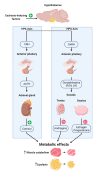Neural Mechanisms of Cancer Cachexia
- PMID: 34439145
- PMCID: PMC8391721
- DOI: 10.3390/cancers13163990
Neural Mechanisms of Cancer Cachexia
Abstract
Nearly half of cancer patients suffer from cachexia, a metabolic syndrome characterized by progressive atrophy of fat and lean body mass. This state of excess catabolism decreases quality of life, ability to tolerate treatment and eventual survival, yet no effective therapies exist. Although the central nervous system (CNS) orchestrates several manifestations of cachexia, the precise mechanisms of neural dysfunction during cachexia are still being unveiled. Herein, we summarize the cellular and molecular mechanisms of CNS dysfunction during cancer cachexia with a focus on inflammatory, autonomic and neuroendocrine processes and end with a discussion of recently identified CNS mediators of cachexia, including GDF15, LCN2 and INSL3.
Keywords: GDF15; INSL3; LCN2; autonomic nervous system; cachexia; cancer; cytokines; neuroendocrinology; neuroinflammation.
Conflict of interest statement
D.L.M. is a consultant for Pfizer, Inc. and Alkermes, Inc. D.L.M. is a consultant, has received grant funding and has equity in Tensive Controls, Inc. All other authors declare no conflicts of interest.
Figures




References
-
- Braun T.P., Zhu X., Szumowski M., Scott G.D., Grossberg A.J., Levasseur P.R., Graham K., Khan S., Damaraju S., Colmers W.F., et al. Central nervous system inflammation induces muscle atrophy via activation of the hypothalamic-pituitary-adrenal axis. J. Exp. Med. 2011;208:2449–2463. doi: 10.1084/jem.20111020. - DOI - PMC - PubMed
Publication types
Grants and funding
LinkOut - more resources
Full Text Sources
Miscellaneous

